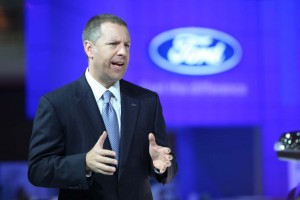With Asia expected to be the engine of its future growth, Ford has outlined an aggressive product roll-out that will put 23 new models in its line-up by mid-decade, with the majority of those earmarked for China, now the world’s largest automotive market.
Ford currently holds just 2.6% of the Chinese car market, largely due to a late start, barely one-sixth the share held by its rival General Motors. But catching up in China – as well in India and other parts of Asia – will be critical to the recently-announced growth plan outlined by Ford CEO Alan Mulally, which calls for the maker to jump from 5.2 million sales annually to 8 million. Last year, the Asia/Pacific region accounted for just 15% of Ford’s global volume, but the maker believes it can push that closer to a full one-third.
Of the 15 new cars planned for China and eight targeting India, the vast majority will be aimed at the smallest and lowest-priced market segments, according to Joe Hinrichs, head of the maker’s Asian operations, below the current subcompact Fiesta. That means less than $14,500 in China, and $8,500 in India, which was recently projected to become the world’s third-largest automotive market by the end of the decade. (For more on that story, Click Here.)
“For Ford, if you want to grow the business and be competitive in China, we have to have a product portfolio that plays where the volume is,” said Hinrichs.
Unlike General Motors, which was one of the first foreign carmakers to make the then-risky decision to invest in China, Ford held out, focusing instead on operations in Thailand, such as the suburban Bangkok facility producing its global Ranger pickup. As it became clear that China would become a major market, Ford raced to catch up. As TheDetroitBureau.com today reports, it is breaking ground on a new $500 million engine plant and will shortly launch a second Chinese assembly plant. (Click Here for the story.)
Those and other investments will support the roll-out of 15 new Chinese models, compared with the current Ford line-up of six vehicles. They will comprise what Hinrichs calls a “balanced portfolio,” but that means most will be targeting the low end of the automotive spectrum. That reflects a second shift in the Chinese market.
In the early years, automotive demand was largely centered in higher-end segments because most buyers were business executives, government officials and others in the emerging Chinese middle and upper classes. But more and more, the focus is on lower-income, first-time buyers, especially as China’s economic boom moves inland from Pacific Coast cities like Shanghai and Beijing.
Making money on a model mix where as many as two-thirds of future products will be smaller than the subcompact Fiesta won’t be easy, the Hinrichs acknowledged, adding that, “It’s all about scale. And it’s all about having a cost base that’s competitive in the market you are serving.”
The Ford executive pointed to the Figo, which launched in India in 2010, as an example of its focus on engineering lower costs into products for the Asia/Pacific market. Ford was able to trim $1,000 out of the production costs of the Figo, a significant amount for something so small. It helps that Ford will eventually sell the vehicle in more than 50 markets, reaping extended economies of scale as a result.
In order to support its ambitious plans for the two largest Asian markets, Ford is not only making billions of dollars of investments in factories and product but also lining up an expanded distribution network that will triple the number of Indian showrooms, to 340 by 2016, with China’s dealer count doubling to 700 by that point. Ford is currently adding two new Chinese dealerships a week.

